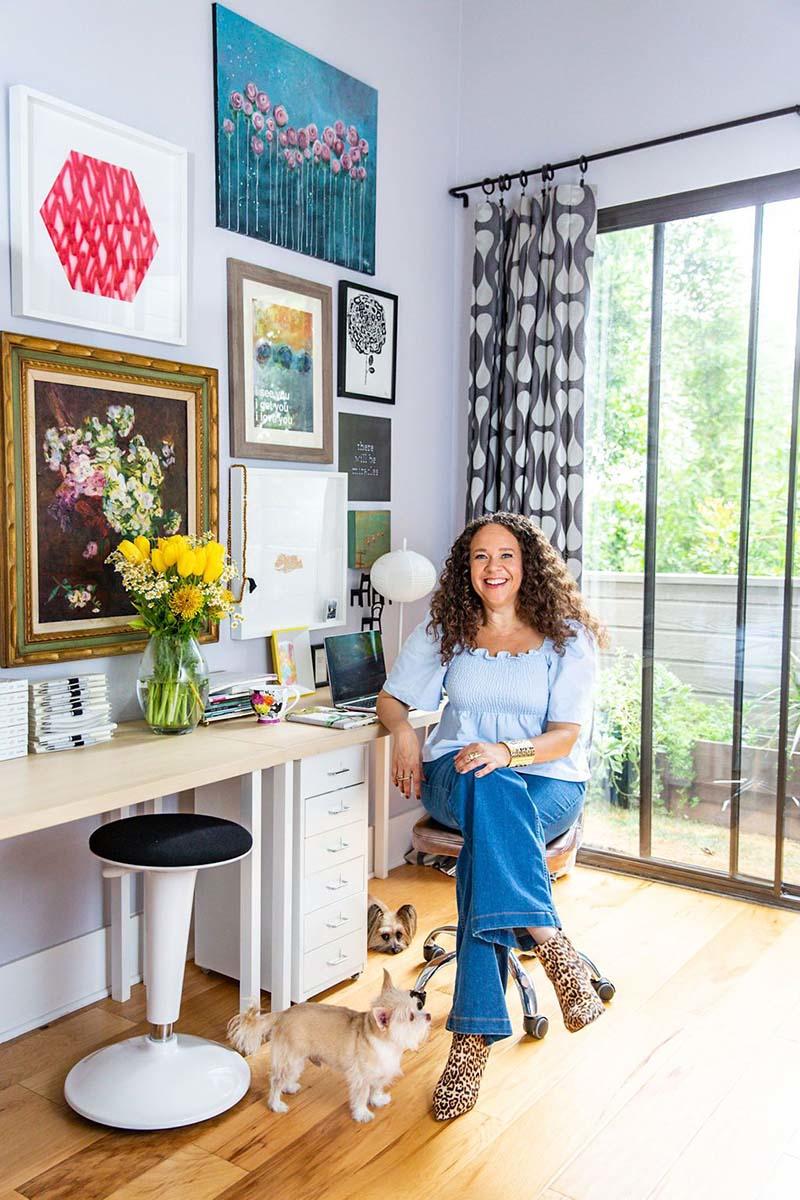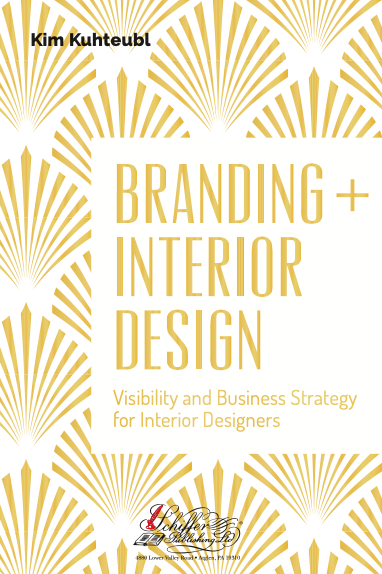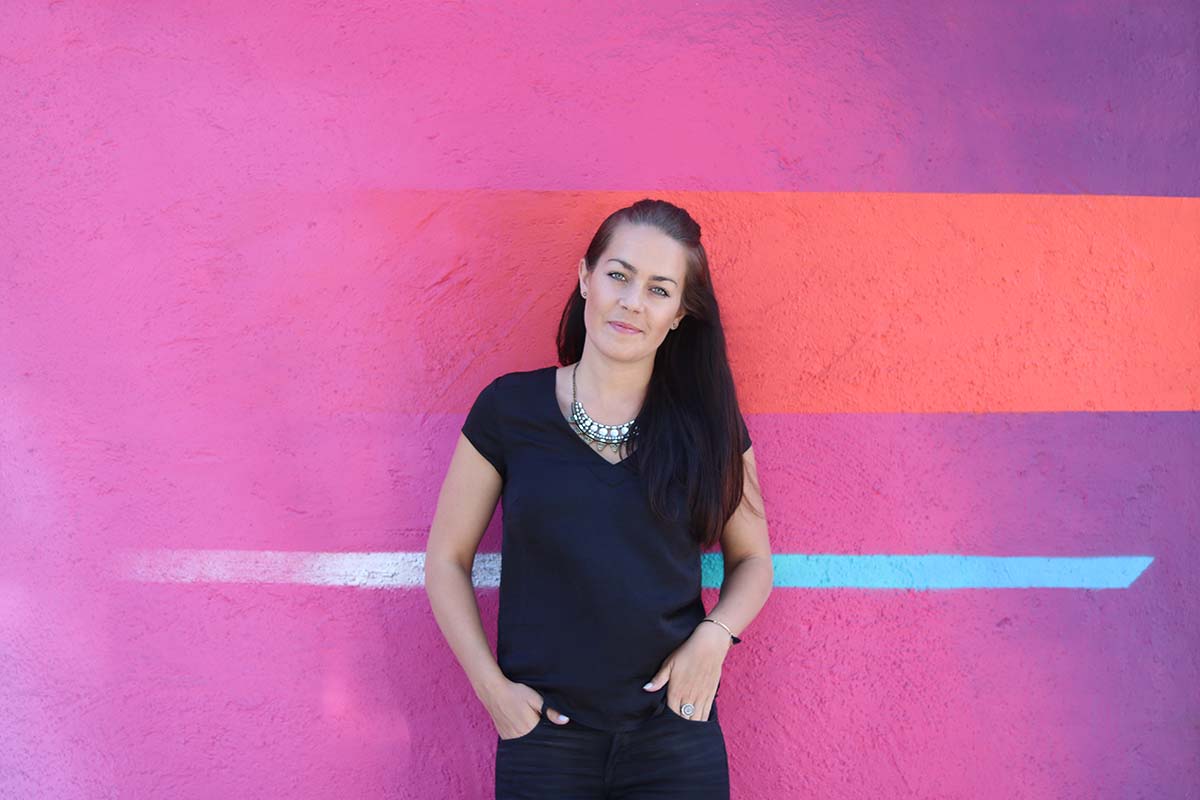When designer Emily Finch made the decision to start her own firm, she found herself struggling to find a foothold. Luckily, her big break coincided with the publication of a book that would come to define her early career: Kim Kuhteubl’s Branding + Interior Design.
Going it alone for the first time can be a daunting task. For interior designers, the decision to start your own firm is difficult enough—the question of how to make a name for yourself is another undertaking entirely. Emily Finch found a resource for navigating those growing pains at just the right time in her career. The San Francisco–based designer had gone through what she called “a Goldilocks situation,” working at three firms of differing sizes before deciding in late 2015 that she was ready to take what she had learned and start her own design business. “When I went off on my own, I didn’t know many people in the Bay Area,” she recalls. “I was prepared to eat canned beans for a year because I thought it was going to be really hard to convince anyone to pay me to do this.”

Luckily for Finch, at the exact same time, Kim Kuhteubl was putting the finishing touches on her first book, Branding + Interior Design: Visibility and Business Strategy for Interior Designers. Informed by the author’s background as an entertainment producer and visibility coach and the founder of the designer-focused strategic consulting firm MeByDesign, the book explores different modes of branding and marketing, and how internal reflection can inform a design firm’s approach to both. “Visibility, for me, is defined from the inside out,” says Kuhteubl. “We often look at external measures of visibility, like the website, or the press. While that’s important, and definitely a part of the strategic initiative we put into place, the biggest shifts in a [designer’s] business always come from the internal work they do. From the things they decide about themselves to the beliefs they hold, it always [starts] with that decision.”
Finch discovered the book just one month after it was published in September 2016. She used its lessons to shape the kind of business she wanted to run, the types of clients she wanted to work with and the structure she needed to implement in order to do so. In the years that followed, the designer found herself returning to the book again and again, relying on it as a guide to navigate growth and maintain the vision she had for her firm. “I went to design school, but we learned very little about the business of being an interior designer. This book filled that gap for me,” she says. “When I first started my business, I said yes to every client who came my way. Reading Kim’s book taught me to explore and embrace my unique vision for my business and the spaces I create, and to work only with clients who value that vision. That was a game-changer for me: I was much happier, my projects were more successful, and those happy clients brought dozens of referrals who shared in that vision as well.”
The Q&A
Emily Finch and Branding + Interior Design author Kim Kuhteubl discuss social media marketing, finding time for your vision and the questions that lead designers to their ideal clients.
Emily Finch: In the book, you say that in order to define our brand DNA, a designer needs a clear vision—a unique story and energy. I’m working on the vision part right now, and I sometimes find it hard to mentally break away from my current obligations or the way my business is running now. What’s your advice for dreaming bigger about the vision of your brand?
Kim Kuhteubl: Start by focusing on the things that you love. A simple way to do that is to make a “love list”—anything from aesthetics or businesses you admire to people, ideas and things that bring you comfort. For example, my list would include my son, my loud little dogs, my Ruggables and my team. As you are focused on those things that you love, you are on a receiving channel. And chances are you’ll start to receive ideas for projects you’d like to do next—maybe the home you’d like to live in next, or the way you want to decorate your bedroom, or the way you’d like to dress. I have clients who shift many parts of their life when they start to do this work. Conversely, you can focus on the things that are driving you nuts; if you find yourself going back to something that bothers you again and again, it’s an energy leak, and you’ll want to deal with it.
And second, build “blue sky time” into your schedule. When you call it “marketing,” I find that people resist it, but call it “blue sky time” and give it half an hour. You don’t even have to be at your desk—you can be on the treadmill or going for a walk. Do what feels good to you and let yourself dream without judgment. Then translate these ideas into action and add them to your calendar.

Finch: I love that. I actually started putting them on Post-it notes on a board in my office.
Kuhteubl: That’s perfect.
Finch: Setting aside time for it in your calendar sounds brilliant, because early in my career, I had all the time in the world to dream, and now I feel like, “This client needs something, that client needs something.” I have to make room for it, or else it won’t happen, and then I won’t have a vision of my brand.
Kuhteubl: You have to have boundaries around your own business. You are your number-one client, and you actually have to treat yourself accordingly. Without you, there is no business. You must take care of yourself at the same level you take care of clients. If you provide a luxury client experience, then you should provide a luxury founder experience as well.
Finch: You also write about batching your days, and thinking about tasks as left-brained versus right-brained. That has changed the way that I work—as opposed to just running around and doing all the things on my list, I have a much better flow and I can work more deeply. When I’m designing, I find that I’m really designing, and then every Friday is for branding, all of the administrative stuff and marketing. But if I only have six hours per week for those tasks, how would you suggest I spend that time in terms of brand visibility?
Kuhteubl: The answer really is contingent upon your vision—the future as you want it to appear and the impact you want to make in it. There’s not one size fits all. I’m coming from an entertainment background, so for me, Instagram, TikTok, Facebook and LinkedIn are simply distribution channels for your vision. What’s more important is to understand: What is my vision, what is the goal of my vision, and which of these distribution channels serves my vision best?
Finch: I get so caught up in thinking I should be doing all of these things. I definitely gave up on doing trendy dances on [Instagram] Reels before even trying. I knew that was not for me.
Kuhteubl: Ask yourself, Am I not liking a certain channel because I have rules about the way that I have to relate to that channel or behave on that channel? For example, [thinking about how] if I’m not doing a Reel and everybody else is, then I’m missing out on that traffic. Or conversely, if everybody is on Instagram, but I know that most of my clients have come from LinkedIn—why have I got my knickers in a twist about Instagram, when I know I should be really paying attention to LinkedIn? Your vision sets the strategy. If you need to know how to spend those six hours, I would ask: What does your vision require you to do, step by step? If you’re really in touch with your vision and it’s clear, you’re going to know what you have to do.
Finch: With social media, do you see a paradigm shift in how formal versus intimate and casual a brand is? On the one hand, we all love watching those TikTok videos about how people make their coffee each morning, but on the other, there’s still value in a well-curated photo.
Kuhteubl: Certain channels favor certain styles of presentation. TikTok is the filterless channel, while Instagram still is more curated, filtered and pretty. I think what is more important is to be authentic to whatever your brand is, and to give yourself permission to experiment if you’d like to try going one way or another. Designers are also learning how to diversify. You can stay loyal to your vision, but meet your clients where they are on different platforms. You have to honor who you are. There will be as many channels as there are individuals.
Finch: I love your advice in the book—and I tell people this all the time, too—to clearly identify your ideal client, down to what car they drive, and speak to that person directly in your marketing. When I don’t know what to write for an Instagram caption, I remind myself of the person I’m talking to. But if I’ve done that and I’m still attracting clients who don’t fit my ideal client profile, does that mean there’s still an issue in my messaging?
Kuhteubl: This is the technical answer, but it’s sort of a metaphysical answer, too, which is that you come in at a frequency. Everybody has a natural way of being, and you might be resonating at a certain frequency, so that’s the client you’re getting—and if you’re not getting the total ideal client, there’s something about what you’re doing that is not bringing in that client. Sometimes, it’s that you haven’t priced yourself high enough, or perhaps you have service policies that don’t match the person you seek to serve. But it’s a complex question, pricing. A lot of things go into that. How much money do you want to make per year? What are your goals? And then I would reverse-engineer it and say: Why do you think you want to work with X client? Who is the ideal client, and [what is your understanding of them]? As an example, a lot of people say, “I want a high-profile client,” and I say, “Do you know what that really means?” Because celebrities come with teams, expectations and visibility that you may not be on the positive receiving end of.
Finch: I get a lot of clients that are ideal in terms of personality—they have a budget, they respect me, they trust me—but they may not be my ideal client for my long-term vision, aesthetically. They definitely pay my bills, but do I turn them down? If I keep taking those clients, then my portfolio looks like something I’m not trying to attract more of.
Kuhteubl: I would say, just because they’re paying your bills doesn’t mean you have to market with them. I’ve worked with a lot of different clients, but I don’t market with all of their stories. That’s where the strategy comes in. Then I would ask: The work that you envision, the next-level work—is that showcased in your portfolio?
Finch: No, I don’t think it is.
Kuhteubl: These answers are complicated, because [if] the clients are great and they respect you, [you’re doing something right]. But if you’re not communicating at all levels—so that’s visually, as well—then yes, therein lies the problem.
Finch: Every time I’ve read this book, I’ve absorbed new lessons. The first time I read it, I was thinking that the marketing stuff didn’t really apply to me because I didn’t have any work to show off yet, but I love the idea of solidifying brand identity near the start of a career. What would your branding advice be for a designer who is just getting started?
Kuhteubl: It’s so dependent on the individual. In broad strokes, it’s just really the message of the book—to be who you are and to stand in your value. If someone is treating you poorly, don’t work with them. If you know your value to be X, and somebody wants to pay you Y—a lot of people will tell you, “Say yes to everything,” but I am not that person. I don’t say yes to everything; I say yes to people who respect me and people who I like. I always say to clients, “When you get somebody on the phone, ask yourself: Do I like this person? Do I like this project? And do they have enough money to do what it is they say they want to do?” And if those three things are a yes, then you can consider it.
Start where you are. Don’t worry too much about the brand. And respect yourself at the level you can in that moment, and that will take you to the next step, and the next step. My advice for designers at every level is to prioritize your point of view, and to try to maintain that harmony of getting paid and exercising creativity.
Homepage image: Emily Finch | Dylan Francis




































